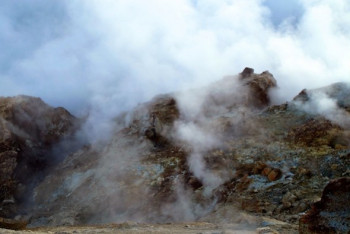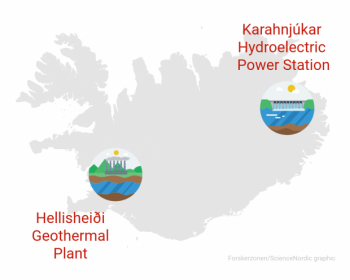Henner Busch
In times of runaway climate change, phasing out fossil fuels and increasing the share of renewables is imperative. But this transition is not without pitfalls as shown by a recent study of two large renewable projects in Iceland.
The recent IPCC report has made it clear that we need to change our energy supply from fossils to renewable energy if we want to avoid catastrophic climate change. This transition has to happen now and it has to happen fast.
The good news is: renewable energy is a wonderful thing. As countless studies have shown, it can be cheap, low-carbon, good for regional development, and bring about great benefits for local people.
But, our new research cautions that these benefits are not inherent to renewable energy development and that each project needs to be carefully assessed on its merits.
Through a case study in Iceland, we show how the “green” image of renewable energy sometimes makes the public overlook the negative impacts of these technologies.
As a result, some of Iceland’s renewable energy resources have been misused to generate private profits for companies outside of the country. While, the benefits for the local population are, at best, questionable and large areas of unique nature have been lost forever.
A developmental model based on heavy industry
In the study, which was recently published in the journal Environment and Planning E: Nature and Space, we investigated the impacts of two large-scale power projects built recently in Iceland: the Kárahnjúkar hydropower project in east Iceland, and the Hellisheiði geothermal plant in the southwest. They are the biggest power plants of their kind in the country.
For our investigation, we analysed scientific literature, and we looked at homepages, reports and statistics. Finally, we interviewed 18 actors from the Icelandic energy sector (5), politicians (5), and experts from NGOs (3) and academia (5).
We found that the two projects were the outcome of an aggressive industrialisation strategy driven by successive Icelandic governments over a number of decades, which have essentially used the country’s renewable energy sources to prop up other environmentally damaging industries.
This strategy entailed minimum environmental regulations, guaranteed low-energy prices, and an industry-friendly tax regime, designed to attract heavy industry, in particular power-intense aluminium smelters to Iceland.
As an incentive, the Icelandic government, together with the country’s publicly owned power company Landsvirkjun, promised to provide the required energy from renewable sources, namely hydro and geothermal, to companies that agreed to set up factories in the country.
This “clean” energy option was offered at very competitive rates and with a guarantee of supply for several years.
In the study, we investigated the impacts of two large-scale power projects in Iceland: the Kárahnjúkar hydropower project in east Iceland, and the Hellisheiði geothermal plant in the southwest. They are the biggest power plants of their kind in the country. (Image: Forskerzonen / ScienceNordic. With graphics from Vecteezy.com)
Let’s look at each project in turn to see what went wrong and what lessons can be learnt.
1: A mammoth hydropower project in a small country
In the early 2000s, large amounts of public money went into the energy sector to live up to the promises made to private sector investors.
One of the following projects is the Kárahnjúkar hydropower project. It consists of several reservoirs, tunnels, and the Fljótsdalur power station. It generates approximately 5,000 GWh per year, accounting for more than one fourth of all electricity produced in Iceland in 2016. All of this energy is used to power a big aluminium smelter built by the global company, Alcoa, on the east coast of the country.
The project serves as an illustrative case for two phenomena: First, it shows how the green label of renewable energy can be misused to justify a costly and arguably quite destructive industrialisation. Second, it shows what can go wrong if a small country makes deals with a big transnational company whose decisions are predominantly driven by the hunt for economic profits.
Destruction in the name of progress
The power plant and the power-intense aluminium smelter must be seen as interlinked projects, because Alcoa’s commitment to build the smelter was the precondition for the power project going ahead, and vice-versa.
The Icelandic government at that time hoped that the development would boost the regional economy in the East of the country. To support this goal, the minister of the environment overrode the environmental impact assessment that vetoed the hydro energy project because of its destructive impact on the local environment.
With the Kárahnjúkar project, unique geological formations and landscapes in and along the Hafrahvammagljúfur canyon were irredeemably lost and downstream ecosystems suffered negative impacts that are yet to be fully understood. For example, the local fish population in Lake Lagarfljót collapsed and Iceland’s wild reindeer population lost part of its grazing and breeding grounds.
Who benefited from the projects?
The contract between Landsvirkjun and Alcoa turned out to be unfavourable for the state-run energy company. The energy prices paid by Alcoa are extremely low and tied to the volatile global market prices for aluminium. This makes revenue for Landsvirkjun very low and unpredictable.
In addition, Alcoa practiced a model of transfer pricing in Iceland to avoid paying the dues taxes in Iceland. This means that the local operation owes a great deal of money to its parent company based in Luxembourg. And so far, the local smelter has not generated any taxable profits, as all revenues are used to pay off the immense debt.
As a result, Iceland has not yet benefited from tax revenue from the smelter. This is particularly scandalous, as Alcoa has described the smelter in its 2012 annual report as a “profit leader” due to the low local energy prices.
2: Rapid expansion of geothermal power meets natural limits
While the Kárahnjúkar hydropower project shows what can go wrong when the green label of renewables is uncritically accepted, the Hellisheiði geothermal plant shows what can happen when aggressive expansion ignores scientific concerns.
The plant is owned by a subsidiary of the publically owned power company Reykjavik Energy (OR) that operates in the capital region of Reykjavik. OR started constructing the plant in 2006. The plant was expanded to its full capacity of 303 MWe and 130 MWth by 2011 against scientific advice, which cautioned against excessive extraction rates.
Output from the field is expected to decrease further by a few percent every year, resulting in big financial losses for OR.
Was it all just hot air?
Similar to the Kárahnjúkar project, the Hellisheiði plant was established to meet the needs of heavy industry and in this case short-sighted political interests forced its rapid expansion beyond its environmental limits.
Not only did the plant lead to a big financial loss for OR and thus the municipalities that owned it, it also caused environmental and health-related problems.
For example, when geothermal energy is harnessed, water is extracted from hot geological formations. When the hot water or steam come to the surface, it often carries contaminants with it, such as sulphur or nitrogen. These elements are then emitted into the atmosphere as gasses or find their way into the waterways.
Sulphuric acid, in particular, is known to cause damage to the local environment and worsen respiratory conditions among local inhabitants. Studies show that health problems in the capital region of Reykjavik can be traced back to the emission of these gases from geothermal sources, including the Hellisheiði geothermal plant.
What can we learn from Iceland?
To make it crystal-clear, we see a transition away from fossil fuels and towards renewable energy as the only acceptable way forward. But the success of renewables is also dependent on the political framework that we set.
These two cases show what can go wrong when short-sighted strategies to foster industrial development dictate a country’s political decision making.
The expected economic gain led to decisions that have degraded the natural landscape of Iceland, and have led to health hazards, with small economic benefits or even losses for the state in return.
Iceland demonstrates that renewable energy is not always beneficial and that we always need to ask questions about the purpose of our energy production.
In particular, there are two questions, which we should always keep in mind when assessing any new energy project: Who benefits from using a country’s natural resources? And who bears the burden if it doesn’t go to plan?
Asking these questions should help us to design the coming energy transition in a manner that really serves our societies as a whole.
This article appeared first in ScienceNordic.com
Read this article in Danish at ForskerZonen, part of Videnskab.dk
Scientific literature


Well framed arguments without emotional hyperbole. You show what can happen when the powerful write the rules to protect themselves, while exposing the small source country to all the risk.
Without tax revenue from Alcoa what did Iceland gain…employment?
Interesting how geothermal hot springs can be degraded with over use. Given time it would likely repair itself?
I’d like to see maps of the flooded tundra landscape and where the airborne sulfur emissions (waste?) goes.
Thank you for your work.
In addition to the comments on Hellisheiði, it should be added that the current project “Gas into Rock” significantly changes the bedrock in the geothermal area. Here, the volume of the crust is significantly changed and increases the pressure on the underlying volcanic system. At the same time, one wonders about steadily increasing seismic activity in the area, which has been increasing noticeably since the project began two years ago.
Local farmers have also been complaining for years about poisoned soils, in which since the operation of the power plant started astonishingly high arsenic levels are observed. Neither the power plant operator nor the Ministry of the Environment or any other government agency has satisfactory information.
Good article anyhow, thanks for your effort!
Ótrúlegt blogg vona að ég geti séð miklu meira af þessu efni